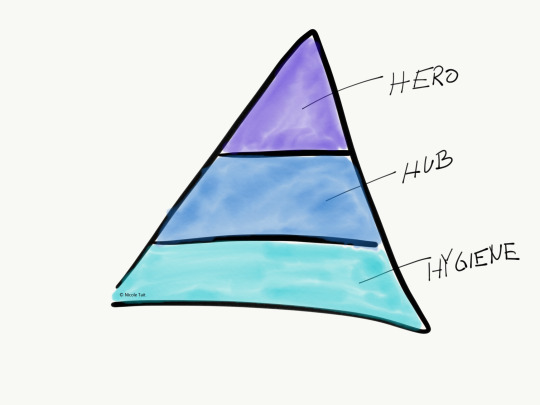The independent retail base is getting weaker and growing your business can be very hard. One approach to support your dealers is to digitize the customer experience. Providing your customers with relevant content and engaging them in a conversation about their needs will create a unique relationship with your brand. In order to grow, you have to adapt content marketing into our communication strategy.
Don't wanna be here? Send us removal request.
Text
Finding Social Media Influencers The No-BS Way in 7 Steps | EHM
0 notes
Text
Content Marketing
How to get started. How to avoid misconceptions. And how to build a solid foundation to grow your business.
Content marketing has been a buzzword in the marketing community for many years. Still, many companies struggle to effectively adapt this concept into their marketing strategy. In this article, I would like to share with you my experience in implementing a content marketing approach into an existing marketing strategy. I include the good, the bad, and the ugly, always providing the tools and action plans to guide you through the entire process.
What is Content Marketing and why is it important to your business?
If the concept of content marketing is not established in your organization, it is essential to have a distinct understanding of what content marketing means to you. And while we are at it, let's also define the term 'content'?
From my experience, the interpretations of this phrase can deviate drastically - from a slogan printed on a t-shirt to a well crafted blog article. You need to specify a 'content piece' or you will end up being overwhelmed with all the projects that are suddenly thrown at you, stopping you from focusing on the actual task at hand: Establishing a constructive content marketing strategy as well as the processes to implement it successfully.
Content Marketing - An easy definition
My definition is quite simple - To me content marketing answers the question 'Why?' Why should a prospect choose to purchase your product rather than that of a competitor. In order to answer this question, you need to create and distribute material (such as blog posts, videos, tutorials, etc.) that highlight features beneficial to the consumer. Ideally, these features show your customers the solution to a problem they do not even know they have. In the end, this should result in informed and engaged prospects that are willing to spend their hard-earned money on your product or solution.

It is also important to introduce a definition for 'content'. The term 'content' is so widely used, that it gets hard to distinguish what is an actual 'content piece'. To me a content piece is a message which is edited and packaged in a way that your audience can understand, share and consume it online, such as a video tutorial, an article on your company blog, an infographic, an animated GIF, and much more.
But why is content marketing important to your business?
In today's consumer environment, people are more keen to understand a product, than in the past. It is no longer enough to simply list certain features on your website while waiting for the customers to come to you with open wallets. All you needed to do as a marketing expert was to raise awareness for the product and provide a working sales channel.
These days, thanks to the endless sources of information that is the internet, people spend a lot more time on learning how to satisfy a certain demand they have, or a problem they would like to solve. If your product does not come up in the search and/or educational information, your product will simply be ignored and excluded from the purchase decision.

The key to a successful content marketing strategy is to focus on the customer, not the product. It should be the goal for you as a content manager to open up a conversation with your audience based on messages that you established in your communication mix. This is a very ambitious task, and it takes a certain skill set to accomplish.
Being a Content Manager - What is your job?
Defining your role as a content manager is the most important thing when implementing the concept into your organization. There are many traps along the way. For instance, people tend to consider you as a fancy copywriter or they limit you on one aspect of your tasks.

But do not forget that your role is not just posting fun stories on the blog but to oversee the entire content marketing circle of creation, publication, promotion, sharing and evaluating success.
As the content manager you should be the advocate for the content throughout the company team and the whole organization as you are the one orchestrating the way a product is perceived by your prospects.
To succeed in this you have to have the necessary product and application knowledge, in order to make smart decisions regarding the content created. Ideally, you consider yourself part of your target group. This will help you better understand the needs of your audience and what they want to learn about your product or solution.
"The best people are the ones that understand content. They're a pain in the butt to manage, but you put up with them because they are so great at the content. And that is what makes a great product." - Steve Jobs -
On a more operational level, these are the tasks you should prepare for:
Translating product features usually provided by your product management, into messages that are understood by your prospects
Managing the editorial process in your organization as well as implementing so-called focus topics. Focus topics are the key messages you always want to hit with everything you publish. It is the essence of your product, the answer to the question 'why?'
Curating user-generated content with the focus topics in mind. This type of content will provide an authentic proof of your message and therefore the foundation to build on in your communication.
As part of your content strategy you might be working with brand ambassadors. Their selection and management of the deliverables should be part of your tasks as well.
Keeping a content inventory will be helpful in the future. It will allow you to better monitor the success of each content piece created and achieve a better return on investment when repurposing certain content elements.
Which departments in your organization should you be working with very closely?
As a content manager you have to understand that you cannot successfully accomplish the task of educating your audience without being able to count on a group of co-workers. Therefore, it is important to identify the different departments and contact people within the organization that you will be working with very closely.
There are probably six departments that you will have the most interaction with: Product management, product marketing, R&D, web editor, public relations and social media.
All these different departments should be included in the regular editorial process.

How do you prepare your organization and your team members?
When introducing a new concept into an existing team you will face some challenges. Here are a few tips that will help you in the transitional phase.

1. Management support
It is very important that your management supports the new marketing approach. Otherwise, you will struggle to get the resources or the backing you need. Unfortunately, it is hard to provide KPI's that prove that what you are doing is actually having a positive effect on the increase of revenue.
Content marketing is playing the long game. To still get continued support, you should present tangible facts, such as potential expense saving or traffic increase to your communication channels.
Once your management is on board and you have a common understanding of content marketing as well as your role as a content manager you need to move on to the team.
2. Team Workshop
You may find a team workshop very useful to get your co-workers engaged with the new concept. A workshop will give you the chance to jointly agree on the procedures and processes that will need to be implemented for content marketing to work and show its full potential.
In this phase, you may find out that content and especially content creation can be a very emotional topic to some people. Be aware that your co-workers have been working hard to produce material too in the past. Make them understand that you are not looking to dictate every project, but to provide a focused framework that will help to stay on-message when communicating to your audience.
3. Create Transparency
As a content manager you have to accept that you will be explaining your role over and over again. The concept might be too abstract for a business or revenue-oriented person to grasp quickly.
It will help your standing if you are forthcoming and open with your work. For instance, create monthly reports on the development of certain messages. Show that the topic you identified as a focus topic is gaining relevance amongst your audience. This can be presented through the usual KPIs, such as traffic volume, split between returning and new visitors, engagement levels as well as content effectiveness.
On top of these KPIs, share your content strategy as well as the long-term goals with your team. Show your vision and try to make your team members understand that content marketing can only be successful if the entire organization gets behind the approach.
In Part 2 - Content Strategy - I will go more into detail about the different content categories you should consider, the importance of knowing your audience as well as how to keep the content marketing circle spinning.
0 notes
Text
Content Strategy
How do you keep your content interesting and audience engaged?
Once you have the necessary processes to create an established content marketing in your organization (see Part 1 - Content Marketing - for details) it is essential to spend some time on drafting a constructive content strategy.
The content strategy will be a part of overall marketing strategy. Should your organization not have a valid marketing strategy in place, don't worry. You can still go ahead and develop a content strategy based on your knowledge of the market as well as the informational needs of your audience. Just be mindful that you need to make adjustments once a marketing strategy is formed.
When drafting the content strategy, it is useful to go through this exercise for every product family or service you have in your portfolio. Each family will have different requirements when it comes to the messages but also with appropriate content distribution, e.g. your communication channels.
Which Communication Channels should you consider and why?
In order to decide which communication channels are the right ones for your organization, a common model in content marketing might provide a helpful framework. I am referring to the 'Three H' - Hero, Hub and Hygiene.

This model is very helpful when deciding on your content strategy. It allows you to structure and focus your need for general content to keep your channels interesting and engaging. It will also remind you to plan for brand-building content to maintain a high level of awareness. Let's look at the three different categories a little bit more closely.
1. Hygiene
The foundation of your content strategy should be your 'Hygiene Content'. This content is always on and can therefore be strongly linked to your social media channels. Hygiene content should be designed specifically for your core audience, providing them with the day-to-day information they need in order to make a purchase decision.
Due to this, hygiene content is somewhat short-lived. Just think about how you consume information. How often do you go back in your feed to find a post that provided interesting information? For me the answer is 'hardly ever'. I would always share or pin it. This is where the hub content comes into play.
2. Hub
Hub content is regular content, which serves the product and shares user experiences. It is scheduled content, designed with your prime prospect in mind. Your hub content should address what your audience cares about and what their concerns and thoughts are. It should answer the question 'Why is your product relevant for this target group?'.
Hub content should ideally be published in a blog or online magazine. Just as the as the name suggests this will be your content storage, your hub - something you can always refer and link back to. Your hub should be a platform that is searchable and well-structured so it is easy for your audience to navigate.
Not only is the 'storage' aspect is important to consider when thinking about starting a blog or online magazine for your hub content. A blog with a good SEO strategy is indispensable when it comes to organic search. As mentioned in Part 1, if your product does not appear in your customers search, your product will simply be ignored and excluded from the purchase decision. Why, you ask? Do not fall into the trap of assuming that your audience knows about your product, even if you have a strong brand to back you up. You will need to put some effort in creating high-value hub content that is search optimized to master this step.
3. Hero
Hero content is very different from Hygiene and Hub as it is never about the direct sale. Hero contents are about raising brand awareness. Hero content does require a greater investment but should also guarantee you more longevity in your communication.
This type of content is mostly related to an event or a significant product launch and could be something like a classic advertising video.

How do you keep your content interesting and audience engaged?
The key element of your content strategy should always be the answers to these questions: Why do you need content? What value are you offering? What type of experience do you want to deliver?
In order to answer these questions you need to know who you are talking to. Defining your target customer is a key factor for success. The best approach to address this task is by identifying your buyer personas.
For this process you can, of course, get the help of an external agency. In my opinion this makes more sense as a verification step later on in the project. You should know your audience best. My advice would be to work with your sales team to get more insights and use their expertise and connections to the market to get the answers you need. Ideally, as the content manager you are very in tune with your prospects and can therefore get the process started.
Important criteria to consider when defining your buyer personas are:
Background - Are they single, married, with kids? What is their level of education?
Demographic factors
Identifiers - What is their demeanor? And what are their communication preferences?
Goals - Primary Goal? Secondary Goal?
Challenges - Primary Challenge? Secondary?
What can your organization do to help them achieve their goals?
What is a common objection - Why won’t they buy your products?
Marketing message per persona - How should we describe our solution?
Once you gathered all this information and structured it in your buyer personas, the next step is to identify which form of content your audience prefers. Also, the story that you choose to tell should spur a conversation among your audience. So try to match your personas to the communication channels you have available. This way you will increase the changes of your target group engaging with your content.

You can positively influence this process by developing different personalities and styles that are attractive to your audience. For example, there could be three different content categories - Informational, inspirational and emotional.
Each of these categories will come with a certain tonality, message and level of product focus. For instance, inspirational content could be a video tutorial shared on youtube using a very open and direct tone of voice.
The final phase of your of the content strategy project should be to establish a content frequency pattern for each communication channel you are planning to use. The more effort you put into this phase the easier it will be to estimate the budget needed when starting with the operational phase as well as the up-keep of the concept over time.
The day-to-day business - Introducing the content marketing circle
The content marketing circle is a useful tool to guide you through the day-to-day operational business of content marketing. You will see the same model with additional intermediate steps. I decided to simplify the concept a little bit by only including five steps. To me these are the essential ones that you need to master in order to be successful - create, publish, promote, share and measure.
As a basis it will be useful to have an editorial process in place. If you have not done that yet, think about the frequency you want to meet with your team based on your posting frequency. I would recommend you have an editorial meeting at least once a month with the entire team. This meeting should cover all the operational topics as well as the posting plan for the next month. An annual editorial meeting is also advised. The discussion in this meeting will help you to focus the content strategy for the next year and revue this year's successes.
Once all the information is gathered I advise you to collect the results in an editorial calendar. Free web-based project-management software such as 'Trello' can provide a great and transparent structure for you and your team to work within.
Now that you have a plan, also known as your content strategy, you will want to execute it. So let's jump into the content marketing circle with the first task.
Create your content
I have to admit, this is the most fun part. You get to be creative and you can put yourself in the mindset of your audience, trying to figure out what they want to hear from you.

But try to keep the overall message in sight. I find it helpful to come up with so-called 'Focus Topics'. These are key messages identified for each product family. They should be openly described to enable different levels of engagement.
In case you are working with brand ambassadors, you can also use the focus topics to make them understand what they should share about your products through their channels. Also, the ambassadors' deliverables should be aligned with the focus topics. This will guarantee you that whatever they send you will fit in your communication mix.
Another advantage of identifying focus topics is that it will allow you to concentrate your communication efforts more efficiently, therefore achieving a harmonized approach throughout all your markets while still providing enough flexibility to allow local adjustments.
When creating your content, do not forget to double check the tonality that you are using for each piece as well as the appropriate content form. You want to make sure that you talk to your audience on their level.
It is also advisable when creating a content piece, to already think about different spin-off versions you could create down the line. This will help you stay in control of your budget while maximizing your output as you do not have to start the production process from scratch each time.
Publish your content on your hub
Once you have created your content piece and it has passed through internal quality control, it is time to publish it. As mentioned previously, it is easiest if you have a content hub that allows you to do exactly this in a visually appealing way. A blog or an online magazine is the best solution, as it allows for SEO as well as archiving of the content.

Your content hub is now searchable and you can also reference back to certain articles. By doing so you will increase your ROI on the content creation.
If you are after a more holistic approach, you should also consider ways to prepare your content so it can be published on numerous platforms. For instance packaging your content piece with all its components in a, what I call, 'Content Container' could provide a great tool for your sales team, distributors or other stakeholders.
Keep in mind that you should provide easy access to these containers within your organization. This way you will increase the likelihood of people actually taking advantage of it. One way of doing this could be a brief document containing download links to all materials (copy, images, links) needed. You can even go the extra mile and make adjustments to the content piece, already fitting the needs for different communication channels such as EBlasts, social posts, etc.
Promote your content
As you can probably imagine, the goal for the promotion phase of the content marketing circle is to spread the word about the great content piece you offer. You need to increase the reach of the piece. This will require you to think a little bit outside the box and work closely with your global PR, Sales and CRM team.

There are many methods that can help you promote your content. Here are a few examples that showed to be very effective for the market I work in.
Content Seeding
Seeding means getting other target group relevant outlets to use your content. This will increase the relevant traffic to your hub. Your PR team can be a great support in accomplishing this task as they have additional contacts to various publications that are frequented by your audience.
CRM Integration
Make sure that your blog or online magazine makes it easy for your prospects to sign up to your newsletter. Once you build a strong database you can use your content to stay in touch with them. Also consider the use of 'gated-content. This refers to material of very high value that your audience can only access once they have signed up to your distribution list. This will help you to build a much stronger and qualified database.
Include your Ambassadors
If you are working with a network of brand ambassadors, they are an indispensable part of your promotion process. Keep them up-to-date with the material that you publish and provide them details they can share through their own channels.
Internal Links
This might be an obvious point but it is also an easy one to forget. You will reach better traffic results if you make sure that you always include links to related articles with your latest post. This will also breathe new life into older articles and keep them interesting and in circulation.
Paid Efforts
Another possibility to promote your content could be by investing some of your budget into paid-efforts such as Google ads or advertorials. This strategy will pay off, if you have a search marketing strategy in place. If this is not the case you might want to establish this step first before launching into this activity.
Offline Activities
Another great way to connect with your audience - and here I mean in the real world - are workshops or masterclasses supporting the message of your content piece. Invite your audience to participate, document the event and share this valuable content again with your community. If you want to adapt this concept I would consider turning this into gated-content for two reasons: To emphasize the value of the material but also to build your customer database.
Share on social media
A key component in the content marketing circle is of course social media. While the content strategy touches more aspects of your marketing mix, being aligned with your social strategy is very important. Social media allows you to spread your message even further to a very targeted audience.

I can only recommend that you also consider developing different sub-strategies for each individual social media channel. Many times companies tend to use the same content throughout all the social touch points, not really optimizing it for the audience or each channel.
If you do not have the resources to make the necessary adjustments that is fine. But your community growth will benefit immensely if you go the extra mile.
Measure and evaluate your results
The final stage is of course the measurement and evaluation stage. It is important to regularly check the performance of your published content elements. Not only will it provide you with a report that you will surely need at least for your next budget meeting, but also will it help you to get to know your audience even better.
KPIs that you should keep track of are the usual online suspects - unique visits as well as the geographic region your visitors are coming from, mobile vs. desktop user, bounce-rate as well as time spent on your article, and of course engagement.
If you have a product that sells online, it can be a powerful tool to include the conversation rate to that list. After all, the ultimate goal of content marketing is to increase your sales.

This final steps concludes the content marketing circle and therefore this article. I aim to provide a better understanding of the practical side of content marketing. I hope you found it interesting.
If you have any questions about my thoughts or techniques, feel free to contact me through LinkedIN.
0 notes
Link
0 notes
Link
0 notes
Link
0 notes